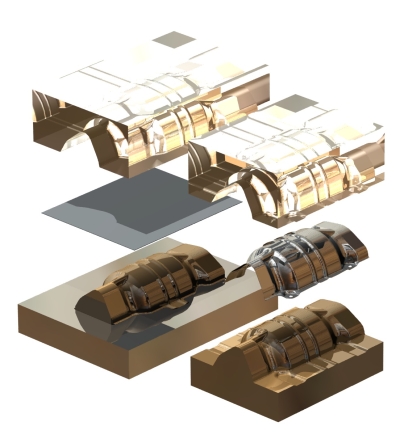Multiple Stage Forming Simulations
So what happens if your part is unlikely to be successfully formed in a single stage? What if you want to see what would happen if you TRIED to form it in a single process?
Obviously, the design of the part is all important here. If by design, the part is fully open (ie: no undercutting) but a rather complicated shape that better judgment suggests would be impossible to form in a singe hit, then it is worthwhile to simulate a single stage form to see what might happen. This is what forming simulation is all about! It is the “try and see” method BUT without cutting tool steel.
The guestimation is low risk because the simulation is done in the virtual environment meaning the cost is only a fraction of what a proto tool (or worse still) a full production tool might cost. Then why simulate a single stage form that is intuitively going to fail? Isn’t this just wasting time and money (although only a small amount)?! If you have a part like this then I will simulate the form in a single stage whether you request it or not. The reason being, the results of such a single stage analysis provides valuable insight into what the requirements are for a pre-form or pre-draw tool. A single hit simulation shows where the material is moving and in what directions it is straining, so that a pre-draw tool can be designed.

The aim is to ensure that the material limits are not reached by the time the final shape is stamped into the part. For example, a parts geometry might be such that it does not allow material to evenly flow from the blank into the areas where it is needed most. In this case, a pre-draw stage would be designed that is a smooth, flowing surface which might over-draw the part and leave excess material available to hit back down in the final form tool. Of course, many who are toolmakers have experienced this before but have you ever seen it done virtually, without any of the expense of building a tool?
Ok then, what about parts that physically cannot be formed in a single stage because of undercuts or negative angled flanges? In these cases, the geometry is unfolded and undercut analysis is performed. Once all undercuts are removed, the part can be considered for single or multi stage forming. Of course, a final flange or bend stage is needed at the end to put the geometry back in that was unfolded in the first step.
In summary, forming simulation can tackle any multi stage forming job. Naturally, the time to do so is more substantial than that taken to perform a single stage form simulation and hence, the cost to perform multiple stage simulations is scaled accordingly. But I ask you this: Can your business afford to develop difficult parts the old way? Contact us here.
